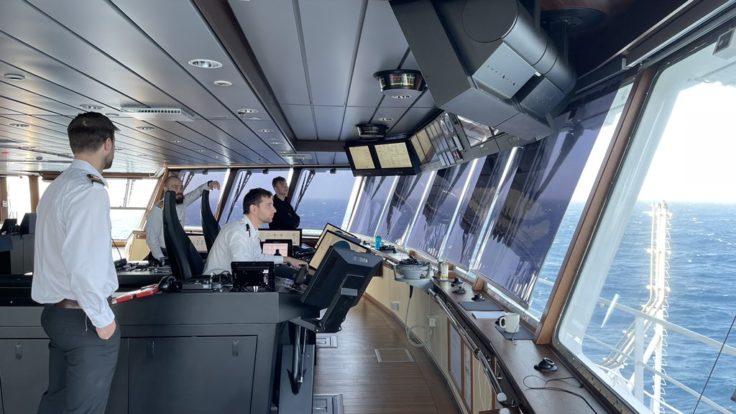First science: aboard the RRS Sir David Attenborough Science Trials
14 February, 2023 Open Oceans, RRS Sir David Attenborough, science
The RRS Sir David Attenborough has begun its polar science trials in Antarctica. A team of 30 national and international scientists, engineers and technical staff are working on the ship for almost two months of science trials. The team are testing a range of scientific equipment and systems, several for the first time – with disciplines cover oceanography, chemistry, and marine biology. They are also working collaboratively to test out the large laboratory facilities to do multidisciplinary research.
Dr Huw Griffiths, BAS Marine Biogeographer, shares a photo journal from the first two weeks of the Science Trials.
On the 1st February, we left the Falkland Islands and started our journey into the Southern Ocean – stopping every few hours to do science. The skies were blue but the sea began to get choppier than the inshore waters around the Falklands.
The first few days were spent with the science teams getting their sea legs and adjusting to the day and night shifts that we will follow to make the most of every science opportunity over the seven weeks. I’m extremely fortunate not to get seasick, but you could immediately feel that we had entered open water. When we’re at sea, all loose items have to be secured – no mugs or laptops to be left unattended.
My personal favourite view from the RRS Sir David Attenborough is down through the glass floor sections on the “bridge wings” (sticking out over the sea). It looks particularly dramatic in choppier weather – I took this video in Drake’s Passage, where despite the glorious sunshine the wind reached up to 58 knots.

Trace metal chemistry was the a huge milestone for the trials team, with the deployment of the CTD – an oceanography instrument used to measure the electrical conductivity, temperature, and pressure of seawater. We were quickly able to return of the first “clean” seawater chemistry samples, representing the first proper science being done with the RRS Sir David Attenborough. A titanium CTD and special lab facilities ensure that the metal of the ship does not contaminate the water samples. The trace metals team take a lot of time and care to avoid contamination. They have to change their clothes and wear hairnets when working in the clean lab and special gloves when setting up the CTD.
The data from CTDs taken all over the world help us to monitor changes in our oceans, including warming, acidification and freshening caused by human impacts. These samples add to 30 years of data on the same line between the Falklands and the Antarctic Peninsula.


Sampling sediment from the sea bed can be helpful in shaping science in many different areas, including biodiversity, climate science, chemistry, oceanography, microbiology. The “Multicorer”, as its name suggests, takes multiple sediment cores (cylinders of mud) at each deployment – we sampled from around 2km in depth. Once the cores are back on the ship you have to get the mud out of the tubes ready for analysis. That’s the fun part – plenty of happy and excited scientists.


Fish and invertebrates spend their lives migrating hundreds of metres up and down in the ocean avoiding the daylight, coming to the surface to feed. This means that we have to fish during darkness. A whole ecosystem that yo-yos through the water at dusk and dawn. We worked through the night collecting animals from the water column – fantastic weather and calm seas made the 4am finish a little easier! We use special nets that can we can open and close at depths of our choosing (depending on where our echo sounders detect shoals of fish). The Rectangular Midwater Trawl (RMT 25) has a mouth opening of 25 m2, and weighs around 1000 kg.


The #RRSSirDavidAttenborough woke up this morning to stunning views of Elephant & Clarence Islands. Elephant Island’s name is attributed to both its elephant head-like appearance and elephant seals. Unlike the crew of the Endurance, we only visited for a few hours! #SDAScience
